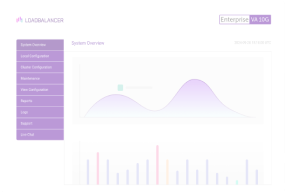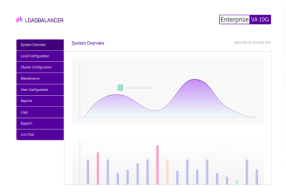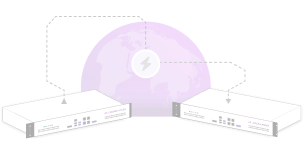Load balancing Skype for Business
Benefits of load balancing Skype for Business
Deploying Skype for Business with a load balancer enables organizations to create a feature-rich highly resilient solution that ensures that wherever staff are located, and however they connect, they can depend on a platform that allows seamless communications wherever and whenever needed using the communications medium of their choice.
About Skype for Business
Skype for Business is a business class instant messaging, voice over IP (VoIP) and video collaboration tool by Microsoft. Since 2015, it has served as a replacement for Microsoft Lync (formerly Microsoft Office Communications Server).
Unlike the consumer version of Skype, the infrastructure for is hosted on Skype for Business Server. This is comprised a number of individual servers including, Frontend/Backend, Mediation, Director and Edge servers. Due to the number of servers and services provisioned, there is inherent complexity in the deployment. This requires a considered approach to high availability and distribution of user traffic.
Why Loadbalancer.org for Skype for Business?
Loadbalancer’s intuitive Enterprise Application Delivery Controller (ADC) is designed to save time and money with a clever, not complex, WebUI.
Easily configure, deploy, manage, and maintain our Enterprise load balancer, reducing complexity and the risk of human error. For a difference you can see in just minutes.
And with WAF and GSLB included straight out-of-the-box, there’s no hidden costs, so the prices you see on our website are fully transparent.
More on what’s possible with Loadbalancer.org.
How to load balance Skype for Business
Loadbalancer.org appliances are configured to present a series of Virtual Servers (VIPs). These VIPs become the connection points for internal and external clients. The load balancer is then able to distribute requests to the Skype for Business servers that make up the various pools.
Direct Routing (DR) mode a.k.a. Direct Server Return (DSR) mode is not supported for Skype for Business.
UDP traffic must be configured with Layer 4 NAT mode.
TCP traffic can use either Layer 7 Reverse Proxy or Layer 4 NAT.
Front end servers protocols
| Protocol | Role | Ports | Load balancing methods |
|---|---|---|---|
| TCP/HTTP | Internal Web Services | Internal Web Services | Layer 7 Reverse Proxy – (Flexible, Source IP and cookie insertion capabilities) |
| TCP/DCOM/RPC | Various DCOM based operations | 135 | Layer 7 Reverse Proxy – (Flexible, Source IP and cookie insertion capabilities) |
| TCP/HTTPS | Internal Web Services: Used for HTTPS communication between the Focus (the Skype for Business Server component that manages conference state) and the individual servers. | 443,444 | Layer 7 Reverse Proxy – (Flexible, Source IP and cookie insertion capabilities) |
| TCP/TURN | Used for call admission control by the Skype for Business ServerBandwidth Policy Service | 448 | Layer 7 Reverse Proxy – (Flexible, Source IP and cookie insertion capabilities) |
| TCP/TLS/MTLS/SIP | Various SIP based communication | 5061 | Layer 7 Reverse Proxy – (Flexible, Source IP and cookie insertion capabilities) |
| TCP/SIP/TLS | Used by the Mediation Server for incoming requests from the Front EndServer to the Mediation Server | 5070 | Layer 7 Reverse Proxy – (Flexible, Source IP and cookie insertion capabilities) |
| TCP/SIP/MTLS | Used for incoming SIP requests for the Response Group application, Attendant (dial in conferencing), the Skype for Business Server Conferencing Announcement service (that is, for dial-in conferencing), the Call Park application | 5071, 5072, 5073, 5075 | Layer 7 Reverse Proxy – (Flexible, Source IP and cookie insertion capabilities) |
| TCP/SIP | Used for incoming SIP requests for the Audio Test service | 5076 | Layer 7 Reverse Proxy – (Flexible, Source IP and cookie insertion capabilities) |
| TCP | Used for call admission control by the Bandwidth Policy service for A/VEdge TURN traffic | 5080 | Layer 7 Reverse Proxy – (Flexible, Source IP and cookie insertion capabilities) |
| TCP/HTTPS | External Web Services – from Reverse Proxy | 4443 | Layer 7 Reverse Proxy – (Flexible, Source IP and cookie insertion capabilities) |
| TCP/HTTPS | External Web Services – from Reverse Proxy | 8080 | Layer 7 Reverse Proxy – (Flexible, Source IP and cookie insertion capabilities) |
Director servers protocols
| Protocol | Role | Ports | Load balancing methods |
|---|---|---|---|
| TCP/HTTPS | Internal Web Services | 443 | Layer 7 Reverse Proxy – (Flexible, Source IP and cookie insertion capabilities) |
| TCP/HTTPS | Inter-server communication between Front End and Director | 444 | Layer 7 Reverse Proxy – (Flexible, Source IP and cookie insertion capabilities) |
| TCP/TLS/MTLS/SIP | Internal SIP communications between servers and for client connections | 5061 | Layer 7 Reverse Proxy – (Flexible, Source IP and cookie insertion capabilities) |
| TCP/HTTP | External Web Services – from Reverse Proxy | 4443 | Layer 7 Reverse Proxy- (Flexible, Source IP and cookie insertion capabilities) |
| TCP/HTTP | External Web Services – from Reverse Proxy | 8080 | Layer 7 Reverse Proxy – (Flexible, Source IP and cookie insertion capabilities) |
Edge servers (external interface)/access (SIP) service protocols
| Protocol | Role | Ports | Load balancing methods |
|---|---|---|---|
| TCP/STUN | Audio/Visual service | 443 | Layer 4 NAT – (Fast Load balancing throughput Source IP persistence) or Layer 7 Reverse Proxy – (Flexible, Source IP persistence) |
| UDP/STUN | Audio/Visual service | 3478 | Layer 4 NAT – (Fast Load balancing throughput Source IP persistence) or Layer 7 Reverse Proxy – (Flexible, Source IP persistence) |
| TCP/MTLS/SIP | Access (SIP proxy) service | 5061 | Layer 4 NAT – (Fast Load balancing throughput Source IP persistence) or Layer 7 Reverse Proxy – (Flexible, Source IP persistence) |
| TCP/MTLS/SIP | Audio/Visual authentication service | 5062 | Layer 4 NAT – (Fast Load balancing throughput Source IP persistence) or Layer 7 Reverse Proxy – (Flexible, Source IP persistence) |
Web conference service protocols
| Protocol | Role | Ports | Load balancing methods |
|---|---|---|---|
| TCP/TLS/STUN/SIP | Web conferencing | 443 | Layer 7 Reverse Proxy – (Source IP persistence) |
Audio/visual service protocols
| Protocol | Role | Ports | Load balancing methods |
|---|---|---|---|
| TCP/TLS/STUN/SIP | Access (SIP proxy), Web Conferencing, Audio/Visual services | 443 | Layer 4 NAT – (Fast Load balancing throughput Source IP persistence) or Layer 7 Reverse Proxy – (Flexible, Source IP persistence) |
| UDP/STUN | Audio/Visual service | 3478 | Layer 4 NAT – (Fast Load balancing throughput Source IP persistence) or Layer 7 Reverse Proxy – (Flexible, Source IP persistence) |


















